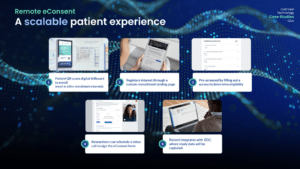As the life science industry moves towards digitalization, eConsent has become an efficient tool to replace traditional paper-based processes. It eliminates roadblocks for patients, sponsors and site staff and engages all of those involved with a simple experience and easy-to-use system.
In the pursuit of gaining a deeper understanding of eConsent in clinical trials, we have gathered the 10 most frequently asked questions. These questions address the complexities of adoption, integration, and compliance measures, which provide valuable insights for those who are considering the implementation of eConsent in clinical trials.
1. Is eConsent only for virtual consenting?
No! eConsent systems should be able to support a variety of workflows to account for a range of patient populations and site needs. A flexible eConsent platform allows you to consent in-person, virtually, or even on paper, all in one platform.

Castor eConsent supports hybrid workflows with visuals, videos, and screen readers, allowing for a process that makes participants feel comfortable, informed, and in control. The platform allows the study team to make video calls, sign forms, and send questionnaires to patients with no additional integration required. Therefore, the study team can view and track their participants’ screening and enrollment progress in real-time.
“With remote consent, you are removing typical geographic barriers to entry, and using our video functionality, you can build a better, more engaging consenting experience with your participants. This positively impacts enrollment timelines and may enable you to recruit from a more diverse pool of participants.”
– Dualtagh Franklin-Charlesworth, Solutions Consultant, Castor
2. What impact has eConsent had on recruitment and patient retention rates?
eConsent has revolutionized the patient recruitment and retention process by streamlining and simplifying the consent process. By digitizing the information and making it more accessible and interactive, eConsent allows for better comprehension and engagement, thereby increasing recruitment rates. Patients can review the consent form at their own pace, revisit sections, and access multimedia content to better understand the trial. This fosters a sense of trust and transparency, making patients more likely to enroll and stay committed to a trial.
Furthermore, with eConsent, data is securely stored, making it easier to keep track of your patient’s progress throughout the consent process. The platform also allows study teams to send reminders to patients regarding consent forms that are awaiting their signature.
“We’ve seen great successes with recruitment using eConsent recently, especially when eConsent is adopted with strategic intent. For example, one of our clients running a pediatric study is seeing a 65% higher enrollment rate with Castor eConsent, compared to previous studies without use of the platform. Other examples include groups who have taken months off their recruitment timelines using eConsent. “
– Kristen Harnack, Director of Solutions Consulting, Castor
3. How does eConsent deal with the complexities of participant identity verification in clinical trials both on-site and remotely?
As part of the consenting process, sites must verify the identity of the participant, confirming that the person providing consent is the intended participant. This is important both from a regulatory perspective and from an ethical perspective to help ensure the safety and well-being of participants taking part in the clinical trial.
During onsite consenting processes, this process is managed as part of the site’s standard operating procedures (SOPs). When utilizing Castor eConsent within an onsite setting, the same principles apply and sites manage the verification of participant identity via their SOPs. Castor eConsent also provides a helpful reminder for the site user to conduct this process by requiring them to confirm that the participants identity has been verified before the informed consent form can be opened for signature onsite.
For remote consenting processes in Castor eConsent, participants are required to create an account within the Castor eConsent patient portal using their email address and a password that they set. When providing an electronic signature on an informed consent form remotely, participants are required to authenticate using their email address and password. This ensures compliance with the relevant regulations including 21 CFR Part 11.
4. How does Castor’s eConsent system support version management, and what mechanisms are in place to notify participants of updates?
Mid-study amendments to the protocol may require updates to be made to the informed consent form (ICF). Participants may also be required to re-consent based on the updated ICF. Castor eConsent can help efficiently manage this process and supports re-consent both at sites or remotely, depending on the study requirements.
In instances where amendments need to be made, the ICF can be duplicated and updated to reflect the changes. Upon approval from the Institutional Review Board (IRB) or ethics committee, the updated version can be published and made available to sites for use.
Clear statuses are assigned to each ICF within the Castor platform to ensure that sites are only able to access the most up to date version of the appropriate ICF. Importantly, the ICF version number, version date, protocol number and IRB approval date can also be recorded to ensure the documentation is correctly version-controlled. A major benefit of this is it helps to reduce non-compliance at sites and reduce the risk of outdated or incorrect versions of the ICF being used.
For participants re-consenting remotely, they are notified via email and can access the updated ICF through the Castor eConsent patient portal for remote signing. For participants re-consenting at the site, they are notified by the site and can review and sign the updated ICF during their visit. By being able to support this hybrid approach, Castor provides flexibility and ensures re-consent is captured efficiently based on the needs of the patient and site.
“It’s good to remember that when using eConsent from Castor, you can ensure that sites are always using the latest and greatest informed consent form (ICF). This reduces risk and ensures a smooth, efficient signing process for patients whether they are providing initial consent or re-consenting to an updated version of the ICF.”
– Dualtagh Franklin-Charlesworth, Solutions Consultant, Castor
5. Can eConsent be built and tested without revealing personal identifiable information (PII)?
eConsent can be built and tested without revealing personally identifiable information (PII). During the development and testing phases, developers can use de-identified, anonymized, or synthetic data to simulate real-world scenarios and validate the functionalities of the eConsent system. This ensures that the system is rigorously tested for accuracy, reliability, and security without compromising patient privacy.
In practice, eConsent systems are designed to uphold the highest standards of data protection and privacy. Castor’s eConsent incorporates robust encryption and access control mechanisms to safeguard PII. Additionally, these systems are compliant with data protection regulations such as the General Data Protection Regulation (GDPR) in Europe and the Health Insurance Portability and Accountability Act (HIPAA) in the United States, ensuring that PII is handled with the utmost care and confidentiality.
“Castor has strict security around any personal identifiable information (PII) gathered. Any demographic data gathered for tokenization by a sponsor, or CRO will be strictly controlled and encrypted. The sponsor or CRO will not have access to that PII. It will only be available to clinical staff with proper levels of permission.”
– Kristen Harnack, Director of Solutions Consulting, Castor
6. Which countries have adopted eConsent? How can I find out about my country?
eConsent has been adopted in many countries across the globe, particularly in regions with advanced healthcare and technology infrastructures such as North America, Europe, and parts of Asia-Pacific. Regulatory bodies in these regions, such as the U.S. Food and Drug Administration (FDA) and the European Medicines Agency (EMA), have issued guidelines and frameworks to facilitate the adoption of electronic informed consent in clinical trials.
Locating country-specific information about eConsent adoption requires studying the records of the agencies that govern clinical trials in each country. Castor has a white paper that tracks the status of eConsent adoption across 18 countries. Stay tuned to our resources page for our forthcoming updated resource, eConsent readiness in 24 countries.
7. How do Castor eConsent and Castor EDC interact?
Castor’s eConsent and Electronic Data Capture (EDC) systems can work in tandem to streamline the clinical trial process, enhancing efficiency and ensuring compliance. eConsent is the initial step where participants provide their informed consent digitally, while Castor EDC is utilized for the collection, storage, and management of the trial data. The interoperability between the systems helps simplify and secure the way data is handled in clinical trials.
Once consent is obtained in Castor eConsent, the participant’s data, such as demographic information and consent status, is automatically transferred to Castor EDC. By having a continuous flow of data between the consent process and the data capture phase, researchers can review real-time information, patient-reported outcomes assessments, and other documentation made possible from central cloud storage that is immediately accessible to the clinical teams.
8. What integrations are available with Castor?
Castor is a fully interoperable platform that can integrate with many sources of data, such as devices/wearables, EHR’s and other tech systems.
The Castor platform is an API-first product – meaning we develop the API endpoints before developing the front-end features, allowing for strong integration capabilities. We have also built webhooks for eConsent, which enable efficient, real-time integrations with external tools.
9. Is eConsent an additional cost when building eCRFs?
We recognize that sponsors and clinical teams designing clinical trials have different requirements they need to fulfill. Given the diversity of current clinical trials, a one-size-fits-all approach to clinical trial administration makes little sense. Castor solutions are priced with those truths in mind.
“The Castor portfolio of products is definitely modular. You can pick and choose the elements you need for your study. The elements include Enrollment, Pre-screening, eConsent, EDC, and others. So, eConsent is its own line item.”
– Sébastien Bohn, Head of Product Management, Castor
10. Can I do a test environment in Castor eConsent?
Yes – It is possible to create a test environment with Castor’s eConsent. Our team is happy to find the best solution to meet your study’s needs. Contact us today to learn more.
Still wondering if Castor’s eConsent fits in your workflow? Watch the on-demand recording of the Product Spotlight webinar “Dive deep into Castor’s eConsent” to hear the full conversation and see a demonstration of the solution.


